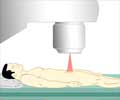Oregon scientists say a simple test can identify men at high risk of life-threatening prostate cancer even after a biopsy finds no signs of it. The key, researchers say, is "PSA density," which compares the size of a man's prostate with his levels of a cancer-related protein called prostate-specific antigen.
Men with the highest PSA densities were much more likely to later be diagnosed with aggressive cancers than men with lower scores in an Oregon study, even though both groups had clean prostate biopsies.If it survives scientific review, it could help save the lives of men with serious cancers and avoid repeated biopsies in others.
"It's that 1-in-10 men that do have a life-threatening cancer that we wanted to identify," said Dr. Mark Garzotto, an Oregon Health & Science University Cancer Institute researcher, who recently presented the study at a cancer conference in Florida.
Prostate cancer will kill about 27,000 U.S. men this year. Doctors usually check for tumors with a prostate biopsy, which uses needles to gather cells from the gland.
More than a million U.S. men get prostate biopsies each year. The tests find more than 200,000 tumors, meaning many cancer-free men get unneeded biopsies.
Studies estimate that the test fails to find the tumor in 20 percent to 33 percent of men who have one, usually because the needles sample only bits of the gland.
Advertisement
To narrow the need for repeat tests, Garzotto and co-workers studied 511 patients at the Veterans Affairs Medical Center, where he works. All the men had clear initial prostate biopsies. But 112 were later found to have cancer, 52 of them aggressive tumors that can be deadly.
Advertisement
By 2 years after their clean biopsy, 23 percent of the men in the high-risk group had aggressive cancer compared with 4 percent of low-risk men, Garzotto said.
At four years, the rate was 36 percent in the high-risk group and 9 percent in the other.
"I feel more comfortable now about recommending repeat biopsies to this (high-risk) group," he said.
Another simple test may identify which men with advanced prostate cancer have the worst outlook, according to a different OHSU study presented at the Florida conference.
Dr. Tomasz Beer found that among men with advanced cancer, those with the highest level of C-reactive protein died significantly sooner than men with lower levels.
C-reactive protein is a sign of inflammation, which doctors increasingly think is "associated with cancer progression and cancer resistance to treatment," Beer said.
Source-Bio-Bio Technology
SRM



![Prostate Specific Antigen [PSA] Prostate Specific Antigen [PSA]](https://www.medindia.net/images/common/patientinfo/120_100/prostate-specific-antigen.jpg)







